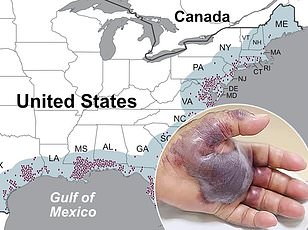Beachgoers urged not to enter water with open wounds, piercings or tattoos as Rhode Islander dies from flesh-eating disease
- READ MORE: Beach trip could lead to deadly bacterial infection, experts warn
Summer beachgoers across the US are on high alert following another death caused by a flesh-eating bacteria that lurks in water.
A Rhode Islander became the latest victim to die from vibrio vulnificus this week, marking the first death in the state since 2017.
His death followed the passing of a tragic Texas father who waded in water in flip-flops.
Vibriosis, the infection caused by vibrio, kills around one in five patients, some within days.
In the most dire cases, the bacteria causes necrotizing fasciitis – essentially eating you from the inside out and rotting the flesh.

Dangerous bacteria lurking in coastal waters, as well as rivers and lakes, are becoming more prevalent with warming ocean temperatures. MRSA and enteroccus are some other examples of harmful bacteria
Eating seafood harboring the bacteria can also cause life-threatening sepsis, an immune response so strong that the body starts attacking its own cells.
The Rhode Island Department of Health has not yet responded to questions regarding which beach the resident had visited or if officials conducted testing in the surrounding areas for evidence that the bacteria is more widespread.
Still, they urged anyone with an open wound, new piercing, or tattoo to steer clear of the ocean, rivers, and lakes this summer.
Vibrio thrives in warm seawater and the mixture of fresh and saltwater found where rivers and oceans meet.
When the bacteria enters an open wound it can enter the bloodstream.

Rhode Island beaches get around 10,000 visitors in a single day during the summer months, meaning thousands could be exposed to the bacteria in the water
It produces a variety of enzymes and toxins that break down proteins, fats, and collagen, destroying skin and muscle tissue.
It does this while evading the body’s immune system and resisting immune cells’ attempts to destroy it.
The bacteria trigger a whole-body inflammatory response, which leads to further tissue damage.
The disrupted blood supply to the infected area compounds this damage, resulting in the death of tissue under the skin.
Dr Jerry Larkin, director of the Rhode Island health department, said: "While Vibrio is rare, it is important for anyone at risk to take precautions while spending time in or around brackish water or salt water when the weather is warm.
'Stay out of the water and take precautions if you have a break in the skin or open wound, particularly if you are at higher risk for serious illness.’

The above maps show projections of future spread of Vibrio vulnificus, which is fueled by rising ocean temperatures
Those at high risk of severe infection include infants and young children whose immune systems are not fully developed. Seniors, people with underlying health issues such as diabetes, kidney disease, and liver disease, and pregnant people.
Vibrio sickened 11 people from just three states last summer – North Carolina, New York, and Connecticut. The median age of patients was 70. In the end, four people went into septic shock and five died.
All but one of those exposures were linked back to wound exposure to natural bodies of water.
Already this year, Florida’s Department of Health has reported 28 cases of vibrio, six of which were fatal.
In Texas, meanwhile, 33 cases are detected on average every year, which most occurring between May and October.
Texas native Randy Bunch, 66, was infected with the bacteria after going crabbing in flip flops last month. He had been crabbing in the shallow waters of a boat ramp, a place he'd visited countless times before.

After Adam Perez stuck his toes into some water at a Corpus Christi park, his foot and leg swelled enormously and a giant blister formed, due to vibriosis

Perez had strolled into Waters Edge Park in Corpus Christi and dipped his toes into some water there
He died just a week later, with bruises and blisters all up and down his leg. The nausea and flu-like symptoms causing inflammation all over his body. Blisters were spreading 'like a fire' all over his body before he died.
Also in Texas in 2019, Adam Perez, 42, was hospitalized and lost most of the flesh on the lower half of his right leg after a dangerous dip in Waters Edge Park in Corpus Christi.
He had to undergo four different life saving surgeries including skin grafts over his mangled leg, which will never be the same again.
Some states, such as North Carolina, don’t test their coastal waters for vibrio bacteria ‘as they are naturally occurring in coastal waters.’
North Carolina is home to 25 different beaches visited by millions of people every year.
The most recent 2018 report from Rhode Island officials reported an average case count of 13 per year, with cases spiking in July.
Infections are typically rare in the Northeast, but public health officials warn they could become more common as global temperatures continue to rise. Warming oceans and lakes make a wider area hospitable for harmful bacteria like Vibrio to thrive.
At the time of the outbreak last year that sickened 11 people, the CDC said: ‘Although these cases reported during July-August cannot be solely attributed to the heat waves, the relationship between vibriosis incidence and environmental conditions favorable to Vibrio growth, namely elevated water surface temperatures and low salinity, is well-documented.’
People whose open wounds come in contact with salt or brackish water should wash them thoroughly with soap and clean, running water.
The odds of dying from a wound infection range from 15 percent to 30 percent.
If a person recently exposed has sudden intense abdominal pain, vomiting, diarrhea, a high fever, rapid heartbeat, low blood pressure, and/or a skin infection, they should see a doctor right away who can prescribe antibiotics.











































































































































































































































































































































































































